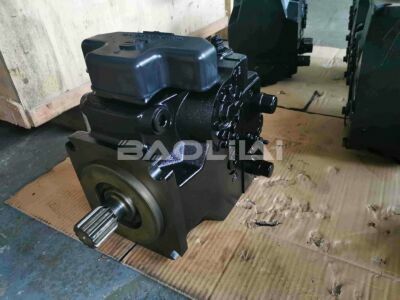Can the plunger pump operate at low pressure
Piston pumps are designed to operate at a wide range of pressures, including low pressures, depending on their specific design and intended application. Piston pumps are positive displacement pumps, which means they use a reciprocating plunger or piston to move fluid through the system. The pressure they can produce or operate at depends on several factors, including the pump design, plunger size, operating speed, and the viscosity of the fluid being pumped.
Low-pressure piston pumps are commonly used in a variety of applications, such as agriculture (for example, for spraying pesticides or fertilizers), car wash systems, and some industrial processes. These pumps are capable of producing relatively low pressures, usually measured in psi (pounds per square inch) or bar, to meet the requirements of a specific task.
High-pressure piston pumps, on the other hand, are used in industrial environments for applications such as high-pressure cleaning, water jet cutting, and high-pressure water injection. They are designed to withstand higher pressures, sometimes reaching thousands of psi.
To operate a plunger pump at low pressure, you may want to consider the following factors:
1. Pump selection: Make sure you choose a plunger pump designed for low-pressure applications. Different pumps have different pressure capabilities, and it is critical to select a pump with the appropriate pressure rating.
2. Plunger size: The size of the plunger or piston in a pump affects the pressure it produces. Smaller plungers are better suited for low pressure applications.
3. Stroke length: Some plunger pumps allow you to adjust the stroke length, which affects pressure output. A shorter stroke can be used to reduce pressure if needed.
4. Speed control: The speed at which the plunger runs also affects the pressure. Slower speed usually results in lower pressure.
H1-P-210-R-A-A-A5-C2-B-D8-C-F8-H6-L-38-L-38-R-P-24-PN-NNN-NNN H1P210RAAA5C2BD8CF8H6L38L38RP24PNNNNNNN
H1-P-210-R-A-A-A5-C2-B-D8-C-F8-H4-L-38-L-38-R-P-24-PN-NNN-NNN H1P210RAAA5C2BD8CF8H4L38L38RP24PNNNNNNN
H1-P-210-R-A-A-A5-C2-B-D8-C-F8-E1-L-38-L-38-W-P-26-PN-NNN-NNN H1P210RAAA5C2BD8CF8E1L38L38WP26PNNNNNNN
H1-P-210-R-A-A-A5-C2-B-D8-C-F8-E1-L-38-L-38-R-P-24-PN-NNN-NNN H1P210RAAA5C2BD8CF8E1L38L38RP24PNNNNNNN
H1-P-210-R-A-A-A5-C2-B-D6-E-F8-E2-K-42-K-42-R-L-24-P4-NNN-NNN H1P210RAAA5C2BD6EF8E2K42K42RL24P4NNNNNN
H1-P-210-R-A-A-A5-C2-B-D6-C-G3-NN-L-40-L-40-R-L-34-PN-NNN-NNN H1P210RAAA5C2BD6CG3NNL40L40RL34PNNNNNNN
H1-P-210-R-A-A-A5-C2-B-D6-C-G2-NN-L-20-L-20-R-L-24-PN-NNN-NNN H1P210RAAA5C2BD6CG2NNL20L20RL24PNNNNNNN
H1-P-210-R-A-A-A5-C2-B-D6-C-G2-NN-K-42-K-42-R-L-24-PN-NNN-NNN H1P210RAAA5C2BD6CG2NNK42K42RL24PNNNNNNN
H1-P-210-R-A-A-A5-C1-B-D8-C-G3-H6-L-23-L-23-W-P-24-PN-NNN-NNN H1P210RAAA5C1BD8CG3H6L23L23WP24PNNNNNNN
H1-P-210-R-A-A-A5-C1-B-D8-C-G2-H2-L-42-L-42-R-P-24-PN-NNN-NNN H1P210RAAA5C1BD8CG2H2L42L42RP24PNNNNNNN
H1-P-210-R-A-A-A4-C2-N-D8-C-G2-H3-L-42-L-42-W-P-26-PN-NNN-NNN H1P210RAAA4C2ND8CG2H3L42L42WP26PNNNNNNN
H1-P-210-R-A-A-A3-C3-N-D8-C-G3-H4-L-40-L-40-R-P-30-PN-NNN-NNN H1P210RAAA3C3ND8CG3H4L40L40RP30PNNNNNNN
H1-P-210-R-A-A-A3-C3-N-D8-C-G3-H3-L-42-L-42-R-P-28-PN-NNN-NNN H1P210RAAA3C3ND8CG3H3L42L42RP28PNNNNNNN
H1-P-210-R-A-A-A3-C3-N-D8-C-G2-H3-L-45-L-45-R-P-24-PN-NNN-NNN H1P210RAAA3C3ND8CG2H3L45L45RP24PNNNNNNN
H1-P-210-R-A-A-A3-C3-B-D8-C-G2-H6-L-45-L-45-R-P-24-PN-NNN-NNN H1P210RAAA3C3BD8CG2H6L45L45RP24PNNNNNNN
H1-P-210-R-A-A-A3-C2-N-D8-C-G3-NN-K-25-K-25-W-P-20-PN-NNN-NNN H1P210RAAA3C2ND8CG3NNK25K25WP20PNNNNNNN
H1-P-210-R-A-A-A3-C2-N-D8-C-G3-H4-L-40-L-40-R-P-30-PN-NNN-NNN H1P210RAAA3C2ND8CG3H4L40L40RP30PNNNNNNN
H1-P-210-R-A-A-A3-C2-N-D8-C-G3-E1-L-40-L-40-R-P-30-PN-NNN-NNN H1P210RAAA3C2ND8CG3E1L40L40RP30PNNNNNNN
H1-P-210-R-A-A-A3-C2-N-D6-C-G2-H5-L-30-L-30-W-L-24-PN-NNN-NNN H1P210RAAA3C2ND6CG2H5L30L30WL24PNNNNNNN
H1-P-210-R-A-A-A3-C2-B-D6-C-G2-H6-L-35-L-35-W-L-24-PN-NNN-NNN H1P210RAAA3C2BD6CG2H6L35L35WL24PNNNNNNN
5. System design: The entire system, including piping size and configuration, and any pressure regulating devices or valves, should be designed to accommodate low pressure requirements.
6. Fluid viscosity: The viscosity of the pumped fluid affects the pressure generated. High viscosity fluids may require higher pressures to move efficiently through the system.
7. Maintenance and monitoring: Regular maintenance is essential to ensure that the pump continues to operate efficiently at low pressures. You may also want to monitor your stress levels to make necessary adjustments.
8. Seals and Gaskets: Make sure the seals and gaskets in the pump are suitable for low pressure operation. Some seals may be designed for higher pressures but may not work effectively at lower pressures.
9. Pressure regulation: Use a pressure regulating device or valve to control and stabilize the pressure within the required low range. This helps maintain consistent performance and prevent pressure fluctuations.

10. Pump Materials: Check whether the materials used in the pump construction are compatible with the type of fluid you are handling at low pressure. Certain fluids may require specific materials to avoid corrosion or damage.
11. Suction conditions: Pay attention to the suction side of the pump system. Proper starting and maintaining adequate suction conditions are important to achieve consistent performance at low pressures.
12. Safety measures: Even when operating at low pressure, safety should be a top priority. Ensure safety measures and precautions are in place to protect operators and equipment.
13. Flow: Low pressure may affect pump flow. Make sure the flow rate meets your application requirements and adjust the pump accordingly.
14. Monitoring and testing: Regularly monitor pump performance at low pressure. Test and inspect to ensure it is functioning as expected.
15. System Compatibility: Ensure that the entire system, including any downstream components or devices, is compatible with the low-pressure operation of the plunger pump.
H1-P-210-R-A-A-A3-C1-B-D6-C-G3-H3-L-35-L-20-R-L-24-PN-NNN-NNN H1P210RAAA3C1BD6CG3H3L35L20RL24PNNNNNNN
H1-P-210-R-A-A-A3-C1-B-D6-C-G2-NN-L-40-L-40-W-L-30-PN-NNN-NNN H1P210RAAA3C1BD6CG2NNL40L40WL30PNNNNNNN
H1-P-210-R-A-A-A3-C1-B-D6-C-F8-H6-K-25-K-25-R-L-24-PN-NNN-NNN H1P210RAAA3C1BD6CF8H6K25K25RL24PNNNNNNN
H1-P-210-R-A-A-A3-C1-B-D6-C-F8-H4-L-35-L-20-R-L-24-PN-NNN-NNN H1P210RAAA3C1BD6CF8H4L35L20RL24PNNNNNNN
H1-P-210-R-A-A-A3-C1-B-D6-C-F8-E1-L-35-L-20-R-L-24-PN-NNN-NNN H1P210RAAA3C1BD6CF8E1L35L20RL24PNNNNNNN
H1-P-210-R-A-A-A2-C3-N-D8-C-G3-NN-L-42-L-42-R-P-24-PN-NNN-NNN H1P210RAAA2C3ND8CG3NNL42L42RP24PNNNNNNN
H1-P-210-R-A-A-A2-C3-N-D8-C-G3-H2-K-45-K-45-N-E-26-PN-NNN-NNN H1P210RAAA2C3ND8CG3H2K45K45NE26PNNNNNNN
H1-P-210-R-A-A-A2-C2-N-D6-C-G2-NN-L-45-L-45-R-L-28-PN-NNN-NNN H1P210RAAA2C2ND6CG2NNL45L45RL28PNNNNNNN
H1-P-210-R-A-A-A2-C2-N-D6-C-G2-NN-L-45-L-45-R-L-24-PN-NNN-NNN H1P210RAAA2C2ND6CG2NNL45L45RL24PNNNNNNN
H1-P-210-R-A-A-A2-C2-B-D6-C-G3-NN-L-33-L-33-W-L-34-PN-NNN-NNN H1P210RAAA2C2BD6CG3NNL33L33WL34PNNNNNNN
H1-P-210-R-A-A-A2-C1-N-D8-C-G3-NN-L-40-L-40-R-P-28-PN-NNN-NNN H1P210RAAA2C1ND8CG3NNL40L40RP28PNNNNNNN
H1-P-210-L-A-A-E8-C3-B-D6-E-G2-NN-L-35-L-35-W-L-30-P4-NNN-NNN H1P210LAAE8C3BD6EG2NNL35L35WL30P4NNNNNN
H1-P-210-L-A-A-E8-C2-N-D6-C-F8-H6-L-40-L-40-W-L-28-PN-NNN-NNN H1P210LAAE8C2ND6CF8H6L40L40WL28PNNNNNNN
H1-P-210-L-A-A-A5-C3-B-D8-C-G3-H6-K-45-K-23-W-P-24-PN-NNN-NNN H1P210LAAA5C3BD8CG3H6K45K23WP24PNNNNNNN
H1-P-210-L-A-A-A5-C3-B-D8-C-G3-H4-L-33-L-33-N-E-34-PN-NNN-NNN H1P210LAAA5C3BD8CG3H4L33L33NE34PNNNNNNN
H1-P-210-L-A-A-A5-C3-B-D8-C-G2-H6-L-33-L-33-N-E-34-PN-NNN-NNN H1P210LAAA5C3BD8CG2H6L33L33NE34PNNNNNNN
H1-P-210-L-A-A-A5-C3-B-D8-C-G2-H5-L-33-L-33-N-E-34-PN-NNN-NNN H1P210LAAA5C3BD8CG2H5L33L33NE34PNNNNNNN
H1-P-210-L-A-A-A5-C3-B-D8-C-G2-H4-L-35-L-35-N-E-34-PN-NNN-NNN H1P210LAAA5C3BD8CG2H4L35L35NE34PNNNNNNN
H1-P-210-L-A-A-A5-C3-B-D8-C-G2-H4-L-33-L-33-N-E-34-PN-NNN-NNN H1P210LAAA5C3BD8CG2H4L33L33NE34PNNNNNNN
H1-P-210-L-A-A-A5-C3-B-D6-C-G3-H3-L-42-L-42-R-L-28-PN-NNN-NNN H1P210LAAA5C3BD6CG3H3L42L42RL28PNNNNNNN
16. Lubrication: Piston pumps usually require lubrication to reduce friction and wear. Be sure to adjust the lubrication system to accommodate lower pressures, as over-lubrication may cause problems such as leakage or contamination.
17. Temperature Control: Temperature affects the viscosity of a fluid and thus the pressure required to move the fluid. Ensure fluid and pump component temperatures are within acceptable ranges for low pressure operation.
18. Start-up and shutdown procedures: Develop clear startup and shutdown procedures to minimize any pressure spikes or unexpected pressure fluctuations during these operating phases.
19. Pressure Relief: Install a pressure relief valve or device to protect the system from overpressure, even when operating at low pressure. This acts as a safety measure to prevent damage.
20. Training and operator knowledge: Ensure operators receive appropriate training in the operation and maintenance of low-pressure piston pumps. This helps prevent errors that could cause problems.
21. Contaminant Control: Low-pressure systems are more sensitive to contaminants in the fluid. Implement filtration or other contamination control measures to maintain system integrity.
22. Consider future needs: If your application may require pressure to change over time, consider the flexibility of a plunger pump to accommodate different pressure levels. Some pumps can adapt more easily to changing requirements.
Overall, successful operation of a plunger pump at low pressure involves a combination of equipment selection, system design, maintenance practices, and operator knowledge. Careful consideration of these factors will help ensure the reliability and efficiency of the pump in your specific low pressure application. Regular inspections, preventive maintenance and a commitment to safety will help keep your plunger pump operating optimally at low pressures.
This article is published by the official website of Baolilai Hydraulics, please contact the author and indicate the source for reprinting:https://www.baolilai-pump.cn/news/1142.html






